#No To PUV Phaseout
Explore tagged Tumblr posts
Text

Piston on Twitter @pistonph:
🤝 CONTRIBUTE TO OUR SOLIDARITY CAMPAIGN FUND ✊🏽
Help us in our fight to defend thousands of informal transport workers' jobs against the govt's planned phaseout of jeepneys. Your donation, however big or small, helps us continue fighting.
2024 Mar. 3
Accepting bank transfers and online payments
47 notes
·
View notes
Photo

Anakbayan-USA stands with the jeepney drivers as they begin their strike today! We commend the 40,000+ jeepney drivers in Metro Manila and beyond for their unity and strength in waging this historic work stoppage. After 5 long years of struggling to participate in the jeepney phaseout and modernization program, the drivers are taking a huge stand to oppose and expose the phase out’s anti-people roll out.
This program would mandate that individual drivers join a cooperative or corporation that must acquire at least 15 modern public utility vehicles, each costing P2.4-2.6 million or $43,000+ US dollars. Only larger businesses or corporations will be able to afford this requirement, resulting in the disappearance of small business owners and ordinary drivers in the jeepney industry.
In the midst of ruinous inflation on top of the pandemic-caused one year service stoppage, the government is forcing drivers into predatory debt with no subsidies. Many drivers will be pushed to work under larger businesses who will further exploit them. Many drivers will lose their livelihoods, and be thrust into an economy where thousands toil as contractual workers or thousands more leave the country each day in search of employment.
Truly, the only winners of the jeepney modernization plan are the big corporations who already have access to huge amounts of capital, the banks doling out the loans and reaping all of the interest, the foreign car manufacturers producing all of the vehicles, and the capitalists amongst the ranks of the government.
The Philippine government wants to push forward a bogus modernization plan to reap the benefits for themselves. Vice President Sara Duterte blasts the strike for its supposed "hardship on students." But what is the reality?
The strike is only temporary, while the lasting impacts of the jeepney modernization pose the greatest hardships on students: higher fares to pay for these new vehicles, joblessness that this plan forces students and their families into, and a lack of future opportunities.
If the government is not willing to provide a modernization plan that has lasting impacts to secure the livelihoods of the drivers and prioritizes working class people, how can we expect that they will do any different for any other sector?
The people deserve safe, accessible, and quality public transportation. Drivers deserve to have true inclusion in the modernization plan that has lasting impacts and secures their livelihoods.
We call on all youth to stand with the striking drivers!
No to Jeepney Phase Out, Yes to Pro-People Modernization!
TAKE ACTION
- Follow the "No to PUV Phaseout Coalition" on FB - Post a selfie or poster with your support for the protest. Use the hashtags #NoToJeepneyPhaseout #NoToPUVPhaseout #SupportTransportStrike - Donate to BAYAN USA to support the strike
-- “No to Jeepney Phaseout! Yes to Pro-People modernization!”, Anakbayan-USA, 5 March 2023
#donation post#philippines#no to jeepney phaseout#no to puv phaseout#support transport strike#labor rights
34 notes
·
View notes
Text
Si Manong Hesus

Minsan ko na narinig sa mga evangelicals (na mostly tahimik today) ang chika, “let Jesus take the wheel.” May kanta pa nga yan.
Well, true yan. Jesus is really driving the wheel every single day. Maraming mga Hesus sa lansangan ang kumakayod at nagpapakahirap bilang mga tsuper ng jeep. Sila ang nagdadala sa atin sa ating mga upisina, paaralan at maski mga simbahan pag araw ng Linggo. Bago pa sumikat ang araw nagmamaneho na sila kasabay ng maraming mga manggagawa at estudyante.
Sabi rin nila iconic at bahagi na ng ating kultura ang makukulay na jeepney. Maraming mga pelikula ni FPJ, merong jeep. Kung hindi ako nagkakamali may pelikula syang jeepney at taxi driver sya. Pero luma na daw ang mga makukulay na jeepney. Hindi na daw ito environmental. Huwaw bigla silang naging climate-champions. Hindi na rin daw ito road-safe. Siguro meron namang katotohanan yan. At sino ba naman ang gustong paulit-ulit na gumamit nang luma at madaling masira kung meron pwedeng ipalit.
Hindi tutol ang maraming mga manong Hesus sa modernization. Pero kung ang paraan ng modernization na itinutulak sa kanila ay para lamang pagkakitaan sila at lalong pahirapan, hindi ito katanggap-tanggap. Gustong igiit sa mga manong Hesus ang napakamahal na imported na jeepney kahit pwede namang gawang lokal na mas mura at mas makakatulong sa lokal na ekonomiya. Gustong itulak ang modernisasyong ng jeepney pero Hanggang ngayon walang plano na ipapalit sa bulok na pangkalahatang sistema ng transportasyon sa ating bayan. Hanggang ngayon ang sistema ng pagkuha o renew ng lisensya at plaka ay delayed at palyado.
Malinaw na sa usapin ng jeepney modernization gusto lamang pagkakitaan at pahirapan ang mga manong Hesus.
Hindi kasalanan ni manong Hesus kung sya ngayon ay umaaray at nagproprotesta. Wag natin silang sisihin sa transport strike. Bagkus samahan natin si manong Hesus at makiisa sa kanya at sa mga kasamahan nya na ipanawagan ang mas maayos, mas komprehensibo at mas makatao at maka-Pilipinong modernisasyon.
Bilang taga-sunod ni Kristong kasama at kakampi ng mga tsuper, samahan at kampihan natin ang maraming mga manong Hesus na nagproprotesta sa linggong ito.
Ang pananamplatayang walang pakielam sa kapwa ay huwad.
- Written by Rev. Joseph San Jose of Open Table MCC
10 notes
·
View notes
Text
9 notes
·
View notes
Text
NO TO JEEPNEY PHASEOUT !!!!!!
SAY HELLO TO A WORSENED TRANSPORT CRISIS BY 2024
By: Mariella Angela H. Olden (December 28, 2023 | 9:25 PM)
Following a meeting with transportation officials, President Ferdinand Marcos Jr. said on December 12 that no further extensions for consolidation of public utility vehicles (PUV) shall be granted.
One of the cultural markers of Philippine identity is the jeepney. Jeepneys have been the primary mode of transportation for Filipinos due to its affordability and accessibility, particularly for students and workers. Furthermore, it has traditionally been the primary occupation of drivers and operators.
In June 2017, the government established the Public Utility Vehicle Modernization Program (PUVMP), intending to replace and eventually phase out traditional jeepneys to improve public transportation. However, with the impending phaseout of jeepneys by December 31, 2023, drivers and operators will be forced to purchase costly modern vehicles supported by the government.
Data from the Land Transportation Franchising and Regulatory Board (LTFRB) indicates that five days before the consolidation deadline, 31,058 traditional jeepneys, or 73.5% of them in Metro Manila, have yet to be consolidated. These unconsolidated units are highly not a minority.
Why should drivers, operators, commuters, and workers fight back? Among the many effects of the PUVMP is the increase in the minimum fare that will continue to make Filipinos suffer. The PUV Modernization program is a business. Corporations and large businesses will take over and have the advantage of raising fares to pay for expensive "modern jeeps." In contrast, this is a big disadvantage to the families of the drivers and operators, who will sink into debt due to the burden of the monthly payment of the modernized vehicle.
In addition, the Department of Energy and LTFRB has reported that the number of registered vehicles in the Philippines exceeds 9 million. Just over 250,000, equivalent to 2% of jeepneys, make up the total.
More detrimental effects of this program include the modern jeepney being way more expensive than the traditional jeepney. The price of a typical jeepney ranges from P150,000 to P250,000. The cost of operating a modern e-jeepney will rise by 1,766.7% to P2.8 million for drivers and operators. Although P160,000 will be given as a subsidy according to LTFRB, which amounts to a mere 5.7% of the jeepney's entire cost, jeepney drivers will be forced to make at least more earnings each day to be able to settle their loan if they were to switch to the modern jeepney.
By the year 2024, the mass transport crisis in the country will worsen. The government cannot fill such a large and significant gap in public transport in the country. With the influx of imported cars, many local manufacturers and industries will be affected.
The PUVMP program is forcefully erasing one of the main parts of our identity as Filipinos and only in favor of a few rich and foreign interests, making the Filipino masses suffer, further impoverished, and left behind.
Drivers, operators, commuters, and workers—
Unite and fight for #NoToJeepneyPhaseout #NoToPUVPhaseout #NoToPUVModernizationProgram!
#philippines#news article#news writing#journalism#writer#publication#jeepney#notopuvphaseout#notojeepneyphaseout#notopuvmodernizationprogram
19 notes
·
View notes
Text
OPINION: STOP THE E-JEEP! #NoToJeepneyPhaseout
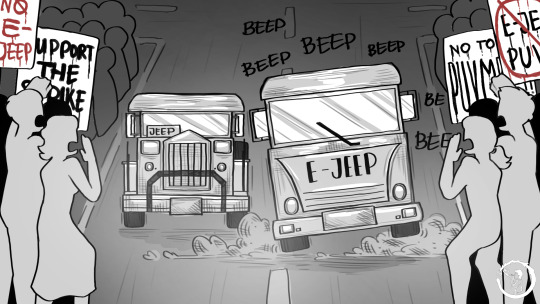
Commuter or not, every Filipino is familiar with jeepneys. Once dubbed “King of the Roads”, jeepneys are a symbol of Philippine culture and resourcefulness, as they were made from converted jeeps left by American troops after World War II. As the most popular public transport vehicle in our country for decades, these jeepneys are now at risk of disappearing, causing public uproar.
The controversy surrounding the phasing out of jeepneys first sparked in 2017 when the government launched the Public Utility Vehicle Modernization Program (PUVMP). The program’s goal is to replace the old model jeepneys with modern electronic jeepneys (e-jeeps) that are claimed to guarantee cleaner emissions and improved safety. This has been met with several worries that could adversely affect the Filipino populace.
Public unrest over the jeepney phaseout has been going on for years. The consolidation deadline for Public Utility Vehicles (PUVs) which included jeepneys, UV Expresses, and Filcab units was extended three times. The first was due to the COVID-19 pandemic and multiple protests from transport groups, which affected the government’s original plan to consolidate PUVs in March 2020. As a result, it was rescheduled at the end of last year, December 31, 2023. The second extension was on January 31, 2024, to allow unconsolidated PUVs to ply their routes with the stipulation of being barred from joining cooperatives and corporations. The third and “final” deadline was on April 30, 2024—three months after the last deadline—to allow driver-operators one last time to consolidate, or else they would not be allowed to ply their routes. Amid these several deadlines, protests and strikes are unwavering as dissents push for the PUVMP to be suspended, arguing that imposing deadline extensions does not address the structural problems of the modernization program.
One day before the “final” deadline, the Land Transportation Franchising and Regulatory Board (LTFRB) declared that unconsolidated jeepneys have a 15-day leeway to continue their usual routes before they are impounded. Again, this is another smokescreen from the systemic issues brought by the modernization program. The PUVMP must be suspended, as it ostensibly presents more problems than solutions. If the PUVMP truly is for the people, why is there a persistent and contentious pushback by the public?
Enforcing deadlines and giving grace periods for jeepney drivers only delays—the government must suspend the PUVMP and reevaluate its effectiveness. Displacing and disenfranchising jeepney drivers from their livelihoods defeats the purpose of an inclusive and sustainable program as the PUVMP endorses itself to be.
Who are those affected?
Jeepney drivers are most affected by the modernization program. If they choose not to consolidate with cooperatives and corporations or cannot afford an e-jeep alone, their vehicles will be impounded, taking away their only source of income. Additionally, commuters, UP Diliman constituents, and other sectors also have to bear the cost of the PUVMP due to the policies and funds allocated to this program.
The transport group for jeepney drivers, Pagkakaisa ng mga Samahan ng Tsuper at Opereytor Nationwide, more commonly known as PISTON, is the leading opposition group against the PUVMP. First established in 1981, PISTON serves as an organization that aims to promote the welfare and democratic rights of jeepney drivers. In 2013, they launched a campaign against the oil price hike, directed at the country’s main petroleum companies, namely Petron, Shell, and Chevron. Since the government has revealed plans to phase out jeepneys over 15 years old, they have been organizing protests against the PUVMP, criticizing its anti-poor policies and prioritizing for-profit corporate consolidation.
The PUVMP pressures jeepney drivers to switch to e-jeeps or new combustion engine vehicles that meet Euro IV emission standards which only permit carbon monoxide (CO) emissions of 1.0g/km for gasoline and 0.5g/km for diesel vehicles. Units and parts that make up the e-jeep are imported from other countries, which is why they are priced as high as PHP 3 million. While the modernization program offers subsidies of PHP 160 thousand through loan programs by the Development Bank of the Philippines (DBP) and the Land Bank of the Philippines (LBP) to help offset the costs, this amount is only 5.7% of the total cost of a modern jeepney. Jeepney drivers state that they will need to make around PHP 3.5 thousand each day to pay off the debt from switching to an e-jeep, but at the moment, they only make around PHP 2 thousand a day.
The large amount of money that needs to be spent transitioning to modern e-jeeps is the main concern of dissent to this program. Replacing a huge fleet of jeepneys requires massive resources, taking away from vital sectors such as education and healthcare. Additionally, the PUVMP disproportionately affects low-income citizens—specifically, jeepney drivers who mostly come from low-income families and struggle to meet the high e-jeep cost. The debt burden forces them to work longer hours just to break even, negatively impacting their livelihood. Jeepney drivers worry that the transition to e-jeeps or new combustion engine vehicles will exacerbate their financial burdens and force them to work longer hours just to break even.
Furthermore, units from local manufacturing companies such as eFrancisco Motor Corporation and Sarao Jeepneys are still priced at around PHP 2.5 million, further putting jeepney drivers at odds with the financial burden of the PUVMP. With large corporations dominating the market and the PUVMP’s policy to consolidate driver-operators to cooperative-led fleets, this raises concerns of corporate takeover and the economic marginalization of jeepney drivers. Since large companies are the ones who have the capacity to fully adhere to the program, jeepney drivers are left disenfranchised because of their financial disadvantage.
Commuters are also affected heavily by this program. Modern jeeps usually charge higher fares because, aside from the initial cost of modernization, their maintenance and repair costs are higher than the traditional jeepneys’. This adds more financial problems to Filipinos already facing higher living expenses as a result of inflation rates. Moreover, unfamiliar technology could present a significant challenge for traditional drivers transitioning to modern jeepneys, leading to potential operational difficulties and increased maintenance expenses.
Constituents of UP Diliman (UPD) share similar concerns. The UP Transport Group (UPTG), which consists of jeepney drivers from all routes around the campus such as Ikot, Toki, UP-Pantranco, UP-Philcoa, and UP-Katipunan, organized a silent strike on December 13, 2023, in protest of the earlier December 31 deadline. Based on interviews with the UPD Vice Chancellor for Community Affairs Roehl Jamon, UP jeepney drivers may have to comply with the modernization. According to Jamon, the only two options they have are for the university to pay for the units themselves, which cost about PHP 1.4 to 3 million each, or for the university to partner with transport cooperatives that already own modernized units and invite them to service the campus, which is the less expensive option between the two. Although the latter is cheaper, this still gives way for corporations to take advantage of the modernization program.
Jeepneys are extensively used by UP college students and students of UP Integrated School (UPIS) for commuting to and from the university campus because they charge less than other PUVs. However, these fares could be completely changed by the PUVMP’s effect on jeepney availability and rates, possibly altering their daily commutes by making them spend more on transport alternatives or by forcing them to look for different routes. This might put additional financial burden as well as longer hours of travel in their everyday life, affecting not only their academic performance but also their general welfare.
Moreover, the PUVMP is taking attention and funding from other sectors that have more pressing needs. In particular, the Department of Education (DepEd) is significantly impacted by lack of funding. Classroom and teacher shortages have been notable areas of concern with an estimated 165,444 classrooms and nearly 90,000 teachers needed. According to DepEd, PHP 105 billion would be needed each year up until 2030 to address the classroom shortage, while PHP 5.6 billion would be needed to hire 20,000 teachers in the upcoming school year, as discussed in the Senate plenary deliberations on the proposed 2024 national budget. Aside from the education sector, the Department of Health (DOH) has been grappling with vaccine shortages, namely pertussis, which has led to 54 infant deaths since the beginning of the year. According to the United Nations Children’s Fund (UNICEF), in 2022, the Philippines was among the top 5 contributors to the 18 million zero-dose children in the world. Despite this and multiple warnings from health authorities, the Philippines still hasn’t fully addressed this vaccine gap, leaving one million unvaccinated Filipino children vulnerable and susceptible to life-threatening diseases such as polio, measles, and tuberculosis. In light of these issues, resources should be prioritized in these matters instead of the PUVMP. Action must be taken immediately to address these pressing concerns and ensure the well-being of the Filipino people.
Are E-jeeps really the “better option”?
According to a study by the Center for Energy, Ecology, and Development (CEED), jeepneys only make up about 2% of the total registered vehicles in the nation and PUVs only contribute about 15% of the total particulate matter emissions in Metro Manila. If the PUVMP aims to transform our public transportation into becoming more sustainable and environmentally friendly, this number does not justify the relentless pressure on jeepney drivers to consolidate. The PUVMP will only contribute 2% to the country’s vehicles that cause pollution. This raises the question of the significance of its impact on saving the environment and reducing emissions in the long run. Additionally, modern jeepneys still run on fossil fuels, such as petroleum oil, defeating the purpose of the program’s goal of creating a more environmentally friendly public transport system. In the same study by CEED, it was argued that solely focusing modernization efforts on jeepneys to reduce air pollution would be negligible. Taking this into account, the government should instead consider upgrading traditional jeepneys to meet the proposed emission standards which would be cheaper for the program.
Furthermore, as said in a paper by the UP Center for Integrative and Developmental Studies, drawing from the current rate of assembly of modern jeepneys, it will take an estimated 270 years before all traditional jeepneys in the country are replaced. This begs the question of why the government keeps enforcing deadlines when it will take almost three centuries before all jeepneys are replaced with e-jeeps.
The PUVMP, while well-intentioned, presents a flawed solution. The environmental costs being too high, the unjust burden on the poor, and the uncertain consequences of such a drastic transition are strong arguments for reconsideration. The government should consider other options like rehabilitating existing jeepneys and using cleaner-burning fuels. One example that can be improved with the government’s help is the rehabilitated jeepney proposed by the Libmanan Transport Service Cooperative (LIBTRASCO). This model includes all government-specified features of the modernized jeepney—such as a side door, a higher ceiling, bigger windows, and even stabilizers to account for the increased height. Compared to e-jeeps, these rehabilitated models only cost around PHP 400 thousand to PHP 500 thousand, making them more affordable for jeepney drivers. Though the rehabilitated jeepney still uses the jeepney’s diesel engine, it can still be adapted to use a Euro 4 engine and even include air conditioning. If the government chooses to work with LIBTRASCO and retrofit the rehabilitated jeepney as an alternative, the Philippines can then improve its transport system while keeping its traditional jeepneys and people’s livelihoods by prioritizing affordability, inclusiveness, and a sustainable future.
Modernization shouldn’t be at the expense of the workers. The primary reason why many are aggressively opposing the program is that the welfare of jeepney drivers was not carefully considered when they should be the center of the solution. For the past years that the modernization program has been implemented, instead of listening to the pleas and concerns of jeepney drivers, commuters, and other constituents, the government has kept imposing the jeepney consolidation and resisting any demands by the public.
Taking all of this into account, we must request the government to prioritize policies that consider the money and power of all citizens, especially those from poor backgrounds. This includes subsidizing the move towards modern vehicles or examining other options that do not oppress marginalized communities. Instead of pushing jeepney drivers to consolidate and buy e-jeeps, the government should consider exploring and supporting initiatives that use cleaner-burning fuels and retrofitting existing jeepneys to meet emission standards to help maintain the environment in its sustainable state without overhauling the iconic jeepney fleet.
Above all else, this transition must be led by the workers—jeepney drivers whom the public has relied on for decades. Development must be made with the public in mind, not without.
// by Kela Alcantara & Xia Mentes
References:
Abarca, C. (2024, March 21). Calabarzon, Metro Manila top classroom shortage list – DepEd. INQUIRER.net. https://newsinfo.inquirer.net/1921036/fwd-on-public-classroom-shortage#:~:text=The%20estimated%20total%20number%20of,country’s%20classroom%20shortage%20by%202030
Ansis, JC (December 14, 2015). "Piston: Continuing to fight for the transport sector". CNN Philippines. https://web.archive.org/web/20190131083905/http://cnnphilippines.com/news/2015/12/14/piston-protests-continuing-to-fight-for-transport-sector.html
Bautista, P., Moya, R. (2023, September 3). Jeepney modernization program: Drivers have a steep price to pay. Philstar.com. https://www.philstar.com/headlines/2023/09/03/2293549/jeepney-modernization-program-drivers-have-steep-price-pay
CEED Office. (2018, November). Just Transition in the Philippines. CEED. https://ceedphilippines.com/just-transition-in-the-philippines/
Conde, M. (2019, November 16). Transport coop makes pitch for ‘affordable, safe’ rehabilitated jeepney. RAPPLER. https://www.rappler.com/nation/244909-camarines-sur-transport-cooperative-rehabilitated-jeepney/
Dimalanta, R. Atienza, J. Samonte E. (2023). Putting Transport Workers and Commuters First: The Route to Just Transition in Public Transport Modernization. UP CIDS Policy Brief. ISSN 2619-7286.
Gatarin, G. (2024), Modernising the ‘king of the road’: Pathways for just transitions for the Filipino jeepney. Urban Governance. 4(1). 37-46. https://doi.org/10.1016/j.ugj.2023.11.002
Golez, P. (2024, January 24). Marcos extends jeepney consolidation deadline til April 30. POLITIKO. https://politiko.com.ph/2024/01/24/marcos-extends-jeepney-consolidation-deadline-til-april-30/daily-feed/
Latoza, G. (2023, December 15). What are UP’s plans for commuters amid PUVMP? Tinig ng Plaridel. https://www.tinigngplaridel.net/up-transport-puvmp/
Magramo, K. (2024, January 16). Philippines jeepneys: Will the loud, colorful vehicles soon disappear from the roads?. CNN. https://edition.cnn.com/2024/01/16/asia/philippines-jeepney-phase-out-strikes-intl-hnk/index.html
Mendoza, T. C. (2021, February). Addressing the “blind side” of the government’s jeepney “modernization” program. University of the Philippines Center for Integrative and Developmental Studies. 1-69. ISSN 2619-7456.
Mondoñedo-Ynot, L. (2024, April 10). April 30 is final deadline for Puv Consolidation. SunStar Publishing Inc. https://www.sunstar.com.ph/manila/april-30-is-final-deadline-for-puv-consolidation
Ombay, G. (2023, November 9). DepEd lacks nearly 90,000 teachers - Pia Cayetano. GMA News Online. https://www.gmanetwork.com/news/topstories/nation/887851/deped-lacks-nearly-90-000-teachers-pia-cayetano/story/
Pabustan, D. (2017, September 21). Euro 4, what does it mean and why do we need it?. AutoDeal.https://www.autodeal.com.ph/articles/car-features/euro-4-what-does-it-mean-and-why-do-we-need-it
Philippine Daily Inquirer. (2024, April 14). DOH’s Lack of Vaccine Urgency. INQUIRER.net. https://opinion.inquirer.net/172935/dohs-lack-of-vaccine-urgency
Presidential Communications Office. (2024, January 24). PBBM approves three-month extension of PUV Consolidation. https://pco.gov.ph/news_releases/pbbm-approves-three-month-extension-of-puv-consolidation/
RAC. (n.d.). Euro 1 to Euro 6 guide – find out your vehicle’s emissions standard. https://www.rac.co.uk/drive/advice/emissions/euro-emissions-standards/
Relativo, J. (2023, December 28). Unconsolidated jeepneys, UV Express “allowed to operate” until Jan. 31, 2024. Philstar.com. https://www.philstar.com/headlines/2023/12/28/2321963/unconsolidated-jeepneys-uv-express-allowed-operate-until-jan-31-2024
Relativo, J. (2024, April 30). Unconsolidated jeepneys given “15-day leeway” after consolidation deadline. Philstar.com. https://www.philstar.com/headlines/2024/04/30/2351543/unconsolidated-jeepneys-given-15-day-leeway-after-consolidation-deadline
Reyes, R. O. (2024, January 29). Jeepney drivers rejoice “partial victory” for phaseout extension. SunStar Publishing Inc. https://www.sunstar.com.ph/tacloban/jeepney-drivers-rejoice-partial-victory-for-phaseout-extension#:~:text=approved%20the%20extension%20for%20franchise
Rivas, R. (2023, March 7). In numbers: Why jeepney phaseout is anti-poor, will do little for environment. RAPPLER. https://www.rappler.com/business/numbers-why-government-phaseout-jeepneys-anti-poor-do-little-environment/
Santos, J. (2024, February 7). Consolidation extension is not what the protest demands. Philippine Collegian.https://phkule.org/article/1106/consolidation-extension-is-not-what-the-protest-demands
8 notes
·
View notes
Text
Nagtry ako sumakay sa modern jeepney. Hindi ako natuwa. Front seat ako kanina,pero hindi ako komportable sa upuan ko, sumakit ang balakang ko. Ansakit sa ulo ng AC, or baka masakit na talaga ulo ko kanina ?... Ang tagal pa umalis, super pinupuno ??? wala bang passenger limit yon ?? kasi pasakay pa ng pasakay along the way e, mga matatanda patatayuin nyo?? Pano pag hindi na kaya ng lamig ? edi ang inet ?? Hindi nakakamodern kung hindi komportable ang pasahero. Feel ko, mas hindi okay ang experience kapag punong-puno doon mismo sa loob ng jeep na yon. Tangina dikit dikit. Mayghadd!! Okay siguro if hindi masyadong madami ang pasahero.
Traditional jeepneys pa rin ako, mas mura pa pamasahe. Mas okay pa air ventilation. Legit, ansakit ng likod ko. Okay sana if isa lang sa unahan eh, kaso pinilit na dalawa, nasa may window seat ako sa front, may sandalan, ung katabi ko wala. Haynako. Okay lang dalawa sa unahan, if sa traditional na jeep kasi, mas malaki leg space don, mas naiituwid mo paa mo?? sobrang lapad din kasi ng balikat ko, parang hanger!!! Ansakit talaga hays.
kaya tamaa!! suportahan ang mass transport strike!! hindi sila ang problema!!
NO TO JEEPNEY PHASEOUT!!!
NO TO PUV PHASEOUT!!!!
YES TO BETTER PUBLIC TRANSPORT!!!!
INUTIL SI MARCOS!
13 notes
·
View notes
Photo
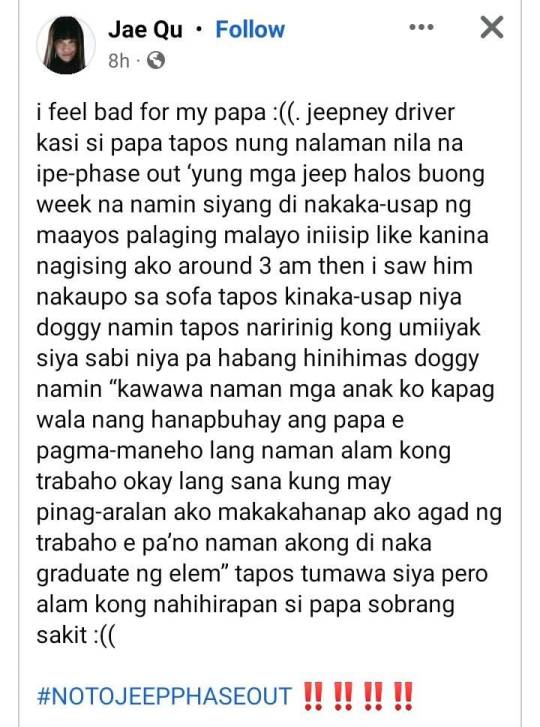
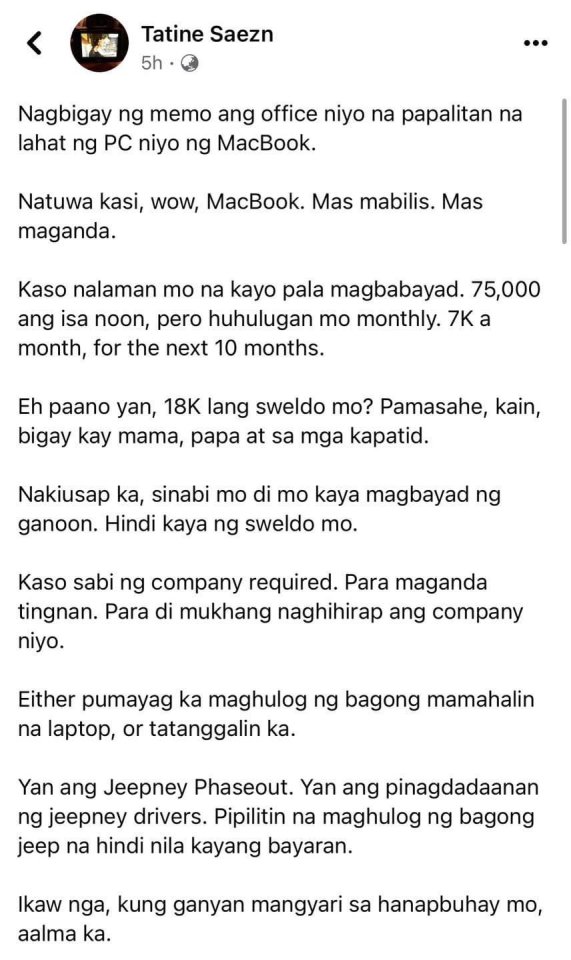
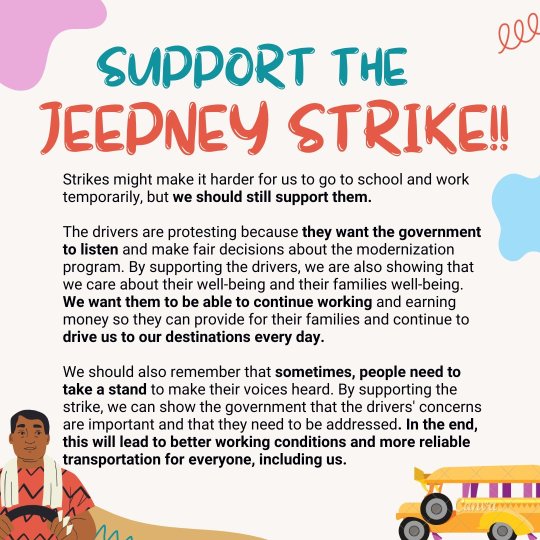
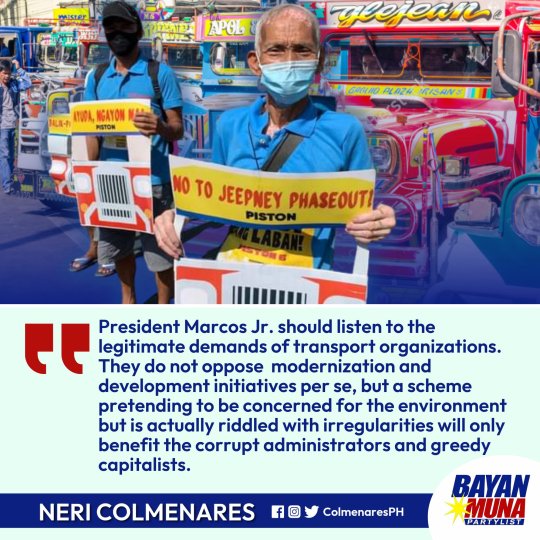
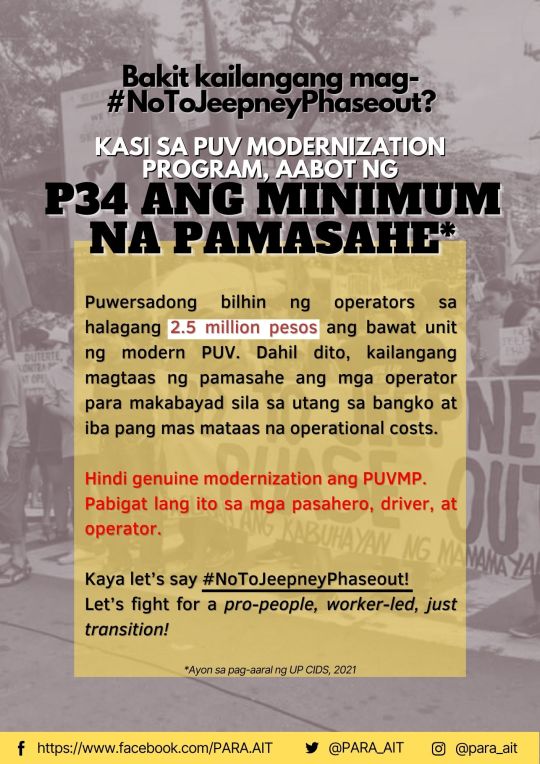
Personal story of a jeepney driver’s child about the phaseout:
[TRANSLATION: I feel bad for my papa :(( He is a jeepney driver so when he learned that the jeep will be phased out, we weren’t able to properly speak to him for almost a whole week since it always seemed that his mind was far away like awhile ago, I woke at around 3 am then I saw him sitting at the sofa speaking to our dog when I heard him crying while stroking our dog. “I feel bad for my kids if their papa has no job since driving is the only thing I know how to do. It would have been okay if I studied something, I’d be able to find a job immediately but what about me who didn’t graduate elementary?” then he laughed but I know papa’s struggling, it hurts so much. :(( #NOTOJEEPNEYPHASEOUT]
Explanation why the Jeepney phaseout is not well-planned:
[TRANSLATION: Your office gave a memo that they will replace your PC with a Macbook.
You and your workmates were delighted because, wow, Macbook. It’s faster. Better.
But you learned that the payment for the Macbook is coming out of your own pockets. One Macbook is 75k PHP, but you get to pay monthly installments. 7k a month for the next 10 months.
But how could that be if your salary is only 18k? Your commute, meals and money to give to your family.
You tried to negotiate with the company, you told them that you can’t pay that amount. That your salary can’t make it work.
But your company tells you it’s required. So that the company will look good. So the company won’t look like it’s struggling.
So either you agree to pay in installments for an expensive new laptop, or you’re fired.
That is the Jeepney Phaseout. That is what the jeepney drivers are going through. They are being forced to pay in installments for a new jeep they can’t even afford.
If this happened to your job, you would be protesting too.]
Why should we say no to the Jeepney Phaseout?
[TRANSLATION: With the PUV Modernisation, jcommute would cost 34 PHP minimum.
Jeepney drivers will be forced to buy the modernised vehicles at 2.5 million PHP for each vehicle. Because of this, the commute cost will have to go up for the operators to be able to pay the bank loans and the other expensive operational costs.
This isn’t genuine modernisation. This is a burden to the commuter, driver and operator.
So let’s say #NoToJeepneyPhaseout! Let’s fight for a pro-people, worker-led, just transition!]
16 notes
·
View notes
Text
NO TO PUV PHASEOUT !
#idk who will read this#but for context:#public utility vehicle drivers are going on a strike in the philippines#because they are being forced to modernize#their vehicles#for an amount that is way out of their capacity and salary#jeepneys are the most budget friendly public transpo in the ph#from a minimum fare of 13 pesos#it might blow up to 40 pesos because of the vehicles they will#now have to drive#so this affects ALL of us#and im just so fucking mad#(i cant even continue doing my endless backlogs#because i need to get this off my chest)#because instead of the people empathizing with jeepney drivers#they instead turn around and blame them for going on a strike#during holiday season#. . . how can you be so selfish ?#i understand that we're all having a hard time commuting now#because the drivers are on strike#BUT DONT U SEE THAT THATS THE FUCKING PURPOSE OF THE STRIKE ?!#it's for everyone to realize just how important jeepneys and jeepney drivers are !#BUT WHY ARE U BLAMING THEM ?!#are filipinos really so fucking insolent that you cant blame the#government for this enforcement ? and u have to turn around#on ur fellow filipino because u think it's them#the jeepney drivers#who are making your life more miserable ?#TAYO TAYO LANG MAGKAKAKAMPI DITO !!!#hindi talaga tayo uunlad kung sari-sarili lang natin iniisip natin
4 notes
·
View notes
Text
Citizen Journalism: Midterms Output | BA Journalism 2A (22-23)
Malolos jeepney barker, drivers detest PUV modernization program
#NoToJeepneyPhaseOut continues to be the unyielding stand of both jeepney barkers and drivers of Malolos Central Transport Terminal after the previous nationwide transport strikes caused by the contentious Public Utility Vehicle Modernization Program (PUVMP) of the administration.
Beside Xentro Mall Malolos sits the Malolos Central Transport Terminal that holds public utility vehicles (PUVs), particularly traditional jeepneys, with both roundtrip and one-way trips to neighboring and distant places alike, such as Plaridel, Guiguinto, Marilao, and Santa Maria, among others.
Mang Renato, a jeepney barker for 21 years and a father of six, said that he won’t necessarily be affected by the jeepney modernization. But he makes clear that he sympathizes with traditional jeepney drivers, who will not be able to afford the modernized ones.
"Sana hindi na matuloy yung mga phase out na yan, kawawa yung mga operator", he expressed. "Paano kung walang pera yung mga operator… paano yung mga drayber. Syempre kung walang pera, wala silang dyip na modern", he continued.
Although his livelihood will not be directly affected by the modernization, he stressed out: "Wala naman ding pinagkukunan ‘yan [mga drayber], syempre masakit din sa kanila yan." To add to his sentiment, he said that there were kind drivers who were willing to give him extra income whenever their jeepneys would be full of passengers, thereby adding to his disapproval of the government’s plan.
Mang JR, a traditional jeepney driver for two decades, also strongly expressed his disfavor for jeepney modernization: "Syempre nakasanayan na namin itong gamitin, tsaka dito ‘di masyadong ano… kapag binyahe na namin, sa amin na kita. Eh kapag sa modern babayaran mo sa gobyerno."
He further explained that the government is basically phasing out their jeepneys and leaving them in immeasurable debt, which they cannot afford to pay. "Pabigat talaga samin talaga", he said.
"Napag-aral ko yung mga anak ko… yung pang-araw-araw namin hanggang sa bahay, kuryente [at] tubig, dito kami kumukuha", he added, emphasizing the importance of his job for his family to stay afloat.
As for his opinion about why the government is pushing PUV modernization in the country, he thinks they are trying to raise the standard of the Philippines’ public transport on par with Hong Kong’s minibuses, vehicles used to reach places standard buses cannot.
Fiercely pointing out the flaws of the jeepney modernization, "Bunso", also a traditional jeepney driver for almost three decades, said that should the jeepney phaseout be implemented, there will be a great loss to every jeepney driver’s family.
"Maraming epekto, dahil gawa nga ng yung dyip namin imbis na wala kaming utang, magkakautang kami na malaki: milyon. Yung dyip naming pansarili, magkakaroon kami ng amo ngayon", he expressed.
Among others, what worries him most about such a policy is its effect on the education of their children: "Kahit paano nakakapagpa-aral kami. Ngayon, ‘pag dumating yang modern na yan, baka hindi na kami makapagpa-aral kahit kinder."
He also cannot help but feel bad for fellow drivers who switched to modernized jeepneys because he is certain they are in debt with millions of pesos. "Malaki hulog doon sa modern... tatlong milyon ‘yon", he said.
Asked if he would ever be in favor of the jeepney modernization program, "Kahit kailan, hindi.", he ended.
The sentiments of Mang Renato, Mang JR, and Bunso were only among the many from the transport sector who will be directly affected by the controversial PUV modernization program that most of them believe to be "anti-poor."
The PUVMP was issued way back in 2017 under DOTr Department Order No. 2017-011, also known as the Omnibus Guidelines on the Planning and Identification of Public Road Transportation Services and Franchise Issuance, during the Duterte administration. Its importance was restated by Transportation Secretary Jamie Bautista under the Marcos administration, with the same aim to provide the Filipinos with a safe and environmentally sustainable transportation system despite the expensive transition that would leave most jeepney drivers behind. | via Andrea Apit, Caryl Flores, Athena Morales, & Nash Villena, BA Journalism 2A

#NOTOJEEPNEYPHASEOUT: Short Documentary #NOTOJEEPNEYPHASEOUT: Short Documentary #NOTOJEEPNEYPHASEOUT: Short Documentary
1 note
·
View note
Text
On Public Utility Vehicle Phaseout
The Marcos Jr. administration is keen to impose the death knell to the livelihood of thousands of PUV operators and drivers.
0 notes
Text

Translation + summary:
Anakbayan on Twitter @anakbayan_ph:
"Why is the fight of the jeepney driver also the fight of the commuter? Why should we act and mobilize?
The mass transport crisis will intensify. The government will not be able to compensate for the huge decrease in public transportation units. Tens of thousands of jeeps will no longer be allowed to operate if they do not abide by the program by surrendering their individual franchises + vehicles and joining cooperatives/corporations to replace the traditional jeeps with "modern jeeps." [As of 2 days ago, ~31k jeeps in Metro Manila have yet to consolidate.] Commuters will be faced with even more difficulties if this happens.
Passenger fares will increase. The PUV Modernization program is a business. The gov wants corporations/coops to have collective ownership over the franchises of routes and new units. They will be able to freely increase fares, which are the only way to cover the costs of providing new jeeps. The fares are projected to reach P40-50, while wages everywhere remain stagnant. [For comparison, current jeepney fares are P13-15.]
The long-term effects of the PUV Modernization program on the state of mass transportation in the country will be massive. It is a complete foreign and corporate takeover of the mass transport system. Local manufacturers and industries will be killed off with the influx of imported vehicles.
Our right to quality transportation that is truly for the masses is at stake. There are 3 days left before the consolidation deadline. There is no other time, we must act now."
#no to jeepney phaseout#no to puv phaseout#philippines#idk if there are many eng-only filipinos here but anw hope this helps 🫶#public transportation#translations
19 notes
·
View notes
Text
im not hearing u out on the puv phaseout if u dont even commute like ?? daming sinasabi di k naman apektado 😂
0 notes
Text
puv phaseout tomorrow. it means mawawala na ang mga old jeepneys starting tomorrow at tataas na rin ang pamasahe bc of the modernization. tataas ang pamasahe at libo-libong tao na naman ang mawawalan ng hanap buhay dahil sa putanginamg binoto niyo. sino ang may kasalanan? si marcos. sino ang maaapektuhan? lahat ng mga mamamayan na nag hihirap sa puder ng mga mayayamang namumuno rito sa pilipinas.
0 notes
Text
Beyond the Headlines: Thoughts about the PUV Modernization Program
The Philippine government is going to be the death of this country.
Saying that this country has been fucked up ever since the new president got elected is an understatement but wow, we are really moving backwards.
Today is December 29, 2023, just two days before they're supposed to phase out the jeepneys. Thousands of drivers and millions of commuters are about to be greatly affected.
The new and improved jeepneys cost 1.4 million to 3 million pesos. That's a huge amount of money, especially for drivers who are already struggling. This move is going to push a ton of hardworking people out of their jobs, making the tough situation in our country even worse.
I strongly disagree with the idea of getting rid of the traditional jeepneys. It just doesn't sit well with me.
It seems like the decision-makers who are involved aren't taking into account the everyday challenges that people like us face. The plan to phase out jeepneys is putting an extra burden on drivers and the countless commuters who rely on these vehicles daily.
I can't shake off the feeling that instead of making things better, this decision might just create more issues for everyone involved. The government needs to reconsider and come up with a plan that doesn't make life so much harder for regular people. We deserve solutions that address our needs and concerns without causing unnecessary hardships.
I strongly believe that there has to be a better way, and it's crucial for those in charge to listen to the voices of the people who will be most affected by this decision.
In conclusion, no to jeepney phaseout!
1 note
·
View note
Text
ik sobrang late magpost pero there will be a mobilization at welcome rotonda, qc against the jeepney and puv phaseout! dumalaw kayo kung kaya!!
0 notes